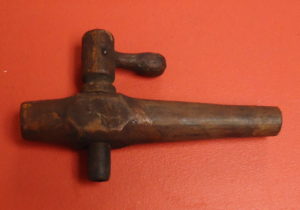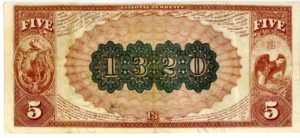“Cash, Credit or Eels”
Hallett Barn
Back in the day, no cash was no problem. Shoppers exchanged simple IOUs for goods or traded everything from fish and feathers to vegetables and eels for the items they needed. This exhibit takes us back a few centuries for a typical round of errands to the general store, the blacksmith, the carpenter and the bank to see what’s available and learn how people shopped and traded in a cash-deprived economy. Like one Falmouth resident, John Tobey (1766-1849). Thanks to a remarkable discovery, we have a window into how this system worked. While renovating his home about a decade ago, an East Falmouth resident found a box secreted in the frame of the building. The treasure inside: a stack of 200-year-old receipts, credit slips, and other business papers that once belonged to Mr. Tobey.
Visit this exhibit in person in the Hallett Barn during our hours of operation, or enjoy the virtual exhibit below.


SEALING WAX STAMP
This is a 19th century brass hand-shaped sealing wax stamp. At the base of the 2 ½ inch hand, there is a stamp for sealing letters and legal documents in wax. In this 1809 letter, Joseph Smalley informed John Tobey that “We have got our salt for five and a half dollars a hogshead and shall sail today.” You can still see traces of the red sealing wax that Smalley used to secure the letter. Both items are from the Museums’ collection and part of our new, virtual “Cash, Credit, or Eels” exhibit.


 PORTRAIT, HAY RAKE AND RECEIPT
PORTRAIT, HAY RAKE AND RECEIPT
In the early 1800s, hay was a common commodity. While the rake above doesn’t quite date back that far, we’ve included the impressive 62-inch long tool in our virtual shopping trip to illustrate the importance hay played in the bartering system. The receipt at the bottom documents that Falmouth resident John Tobey received hay and corn from Deacon Thomas Fish of Quissett on March 13, 1810. A year later, there is a new charge for corn. We have another receipt from Tobey dated November 17, 1819, with his promise to pay Fish $6. On the back, we can see he made payments on April 2, 1827 and February 17, 1830–a very lenient payment plan indeed! The deacon’s portrait (shown above) hangs in Conant House. You can learn more about him and his wife, Susanna, in a previous Untold Tales of Falmouth, The Case of the Missing Unitarians.



JOHN TOBEY DOCUMENT
John Tobey was friends with the Smalley family. They co-owned a couple of small trading schooners. Upon John Smalley’s untimely death, his estate owed Tobey for several items, including rum. It’s probable the sailors on the vessels consumed the large amounts of rum indicated. It’s also possible the spirits were acquired to trade elsewhere.
WOODEN TANKARD
The Bowermans of West Falmouth were among the earliest white settlers, arriving around 1678. Their Quaker religion taught them to value plain design and simple materials such as those of this tankard (c 1790-1840) which belonged to their family. It’s doubtful they would have overindulged in spirits. They probably only drank liquor for medicinal purposes, or if it were a healthier alternative than water. This item was donated to the historical society three years ago by a direct descendant of the family, and given in memory of Cecelia Bowerman Fuglister.
BARREL OR KEG TAP
This essential 19th century tool is 6″ long X 3 1/2″ wide (Unknown donor).



JOHN TOBEY DOCUMENT. This bill shows purchases John Tobey made from Solomon Bourne. Note the charge in December 1825 for butter: 14 pounds, 10 ounces at the rate of 14 cents per pound. That’s $2.05! The back side shows Tobey received a credit of $5.62 for “payment” of two and a half quintles of fish.

 BUTTER CHURN. This 19th century, greenish-brown wood churn has a cover and paddle stick. The churn is 17-3/4″ h (22″ to the top of the handle) x 7-1/2″d.
BUTTER CHURN. This 19th century, greenish-brown wood churn has a cover and paddle stick. The churn is 17-3/4″ h (22″ to the top of the handle) x 7-1/2″d.
BUTTER PRESSES. These butter presses (c1850) are about three inches in diameter. They were used to make a pretty design in the top of a pat of butter.

JOHN TOBEY WOODCUTTING PERMIT
When he was able to pay in kind, Tobey often repaid his debts with wood taken from Mashpee, where his brother Thomas was one of the white guardians appointed to “help” the Wampanoag manage their affairs. John Tobey held permits that allowed him to cut down trees on the Mashpee common and Great Neck. However, numerous men from nearby towns made a habit of taking Mashpee timber without even the fig leaf of a permit. The Native people’s indignation reached a flash point in July 1833, when they stopped carts from hauling wood out of Mashpee. In a move reminiscent of the Boston Tea Party, tribal members threw the wood on the ground and did not allow the intruders to take it away. The outsiders caught removing wood on that day were from Barnstable, but John Tobey had certainly taken a great deal of Mashpee wood in the years 1817-1832, and he may have been perceived as being part of the problem. LEARN MORE
TRANSCRIPT OF WOODCUTTING PERMIT
John Tobey, you are permitted to cut 20 cords of pine wood in Mashpee Commons where it will not interfere with the natives cutting fire wood or fencing stuff; and when it is delivered to the landing you are entitled to ¾ of it. This permit to be void by the last day of December next. January the 10 1824 Ezra Crocker, agent



TOOLS
The hatchet, with separate leather blade case and handle strap, has a 6-inch wide hand-forged iron head and 19-inch long oak handle. The 19th century adze is 25 inches long. An adze is similar to an axe, but its cutting edge is perpendicular to the handle rather than parallel. It is used for smoothing or carving wood.The log carrier is 47 ½ inches wide. The iron tongs are 16 inches long. They would help the woodcutter carry heavy logs. All three items have been in the Museums’ collection for a very long time; the donors are not known.


BANKNOTE
The Falmouth National Bank was founded in 1821. With a few name changes, it operated at the same address on Main Street until 2019. Prior to 1862, paper money was issued by local banks, not by the U.S. government.


 JAMES FISH WALLET.
JAMES FISH WALLET.
James Fish was determined not to lose his wallet, so he wrote his name in it twice, and added a warning to thieves. It’s very likely John Tobey had a similar wallet to keep his banknotes and IOUs organized.
Transcript of poem inside wallet:
Steal not this book
My dearest friend
For fear the gallows
Might be your end
The book is one
The gallows the other
So steal not one
For fear of the other
…………………………..
James F. Fish
Falmouth, Massachusetts
January 8th, 1838

JOHN TOBEY DOCUMENT
This receipt from April 2, 1811 documents that John Tobey owed Joshua Jenkins $31.83 for smith work. Tobey gave Jenkins eels (spelled “els”) and three pair of fowls worth $24.84 for payment. This left a balance of $6.99.


TRIVET. This metal trivet for a sadiron, with likeness of George Washington, is 9-1/2 inches long by 4-1/2 inches wide. Charlotte Price, a former archivist at the Museums, donated the piece which dates from about 1850.
CANDLE HOLDER. It’s possible this hand wrought, adjustable candle holder dates from the 1700s. It is 16-1/2 inches long by 7-1/2 inches wide. The donor is unknown.




